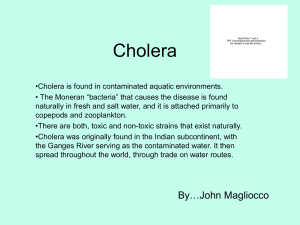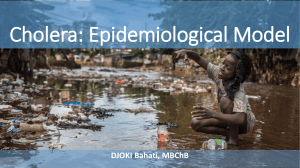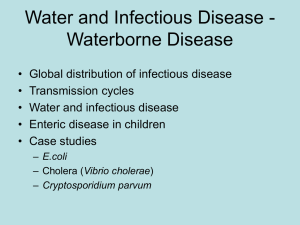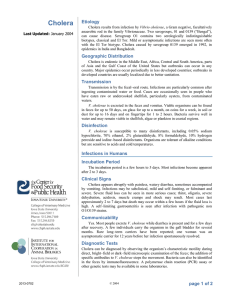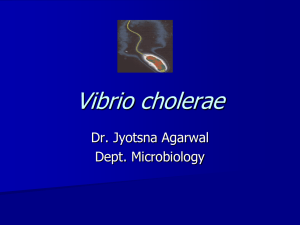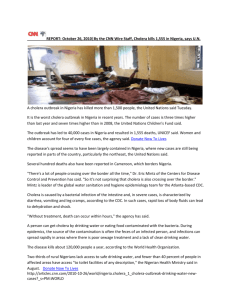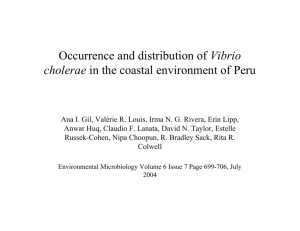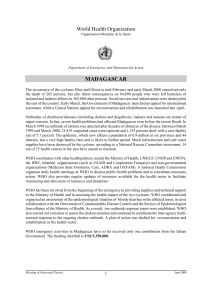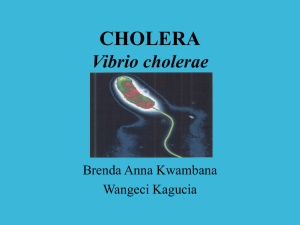4. Cholera
advertisement
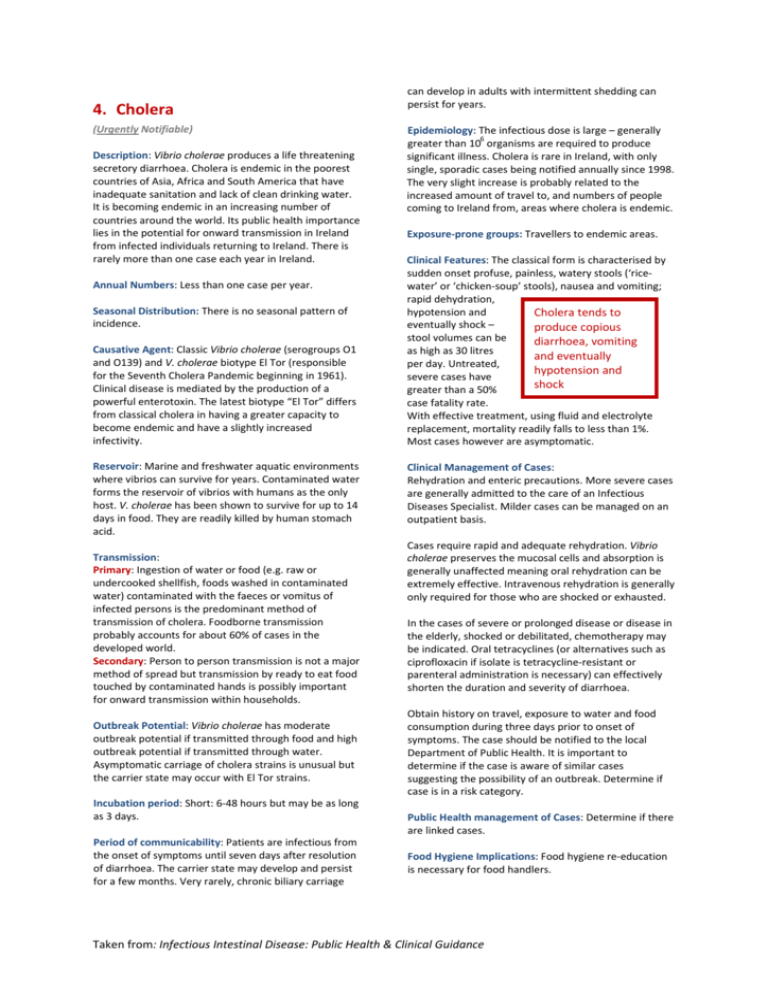
4. Cholera (Urgently Notifiable) Description: Vibrio cholerae produces a life threatening secretory diarrhoea. Cholera is endemic in the poorest countries of Asia, Africa and South America that have inadequate sanitation and lack of clean drinking water. It is becoming endemic in an increasing number of countries around the world. Its public health importance lies in the potential for onward transmission in Ireland from infected individuals returning to Ireland. There is rarely more than one case each year in Ireland. Annual Numbers: Less than one case per year. Seasonal Distribution: There is no seasonal pattern of incidence. Causative Agent: Classic Vibrio cholerae (serogroups O1 and O139) and V. cholerae biotype El Tor (responsible for the Seventh Cholera Pandemic beginning in 1961). Clinical disease is mediated by the production of a powerful enterotoxin. The latest biotype “El Tor” differs from classical cholera in having a greater capacity to become endemic and have a slightly increased infectivity. Reservoir: Marine and freshwater aquatic environments where vibrios can survive for years. Contaminated water forms the reservoir of vibrios with humans as the only host. V. cholerae has been shown to survive for up to 14 days in food. They are readily killed by human stomach acid. Transmission: Primary: Ingestion of water or food (e.g. raw or undercooked shellfish, foods washed in contaminated water) contaminated with the faeces or vomitus of infected persons is the predominant method of transmission of cholera. Foodborne transmission probably accounts for about 60% of cases in the developed world. Secondary: Person to person transmission is not a major method of spread but transmission by ready to eat food touched by contaminated hands is possibly important for onward transmission within households. Outbreak Potential: Vibrio cholerae has moderate outbreak potential if transmitted through food and high outbreak potential if transmitted through water. Asymptomatic carriage of cholera strains is unusual but the carrier state may occur with El Tor strains. Incubation period: Short: 6‐48 hours but may be as long as 3 days. Period of communicability: Patients are infectious from the onset of symptoms until seven days after resolution of diarrhoea. The carrier state may develop and persist for a few months. Very rarely, chronic biliary carriage can develop in adults with intermittent shedding can persist for years. Epidemiology: The infectious dose is large – generally 6 greater than 10 organisms are required to produce significant illness. Cholera is rare in Ireland, with only single, sporadic cases being notified annually since 1998. The very slight increase is probably related to the increased amount of travel to, and numbers of people coming to Ireland from, areas where cholera is endemic. Exposure‐prone groups: Travellers to endemic areas. Clinical Features: The classical form is characterised by sudden onset profuse, painless, watery stools (‘rice‐ water’ or ‘chicken‐soup’ stools), nausea and vomiting; rapid dehydration, hypotension and Cholera tends to eventually shock – produce copious stool volumes can be diarrhoea, vomiting as high as 30 litres and eventually per day. Untreated, hypotension and severe cases have shock greater than a 50% case fatality rate. With effective treatment, using fluid and electrolyte replacement, mortality readily falls to less than 1%. Most cases however are asymptomatic. Clinical Management of Cases: Rehydration and enteric precautions. More severe cases are generally admitted to the care of an Infectious Diseases Specialist. Milder cases can be managed on an outpatient basis. Cases require rapid and adequate rehydration. Vibrio cholerae preserves the mucosal cells and absorption is generally unaffected meaning oral rehydration can be extremely effective. Intravenous rehydration is generally only required for those who are shocked or exhausted. In the cases of severe or prolonged disease or disease in the elderly, shocked or debilitated, chemotherapy may be indicated. Oral tetracyclines (or alternatives such as ciprofloxacin if isolate is tetracycline‐resistant or parenteral administration is necessary) can effectively shorten the duration and severity of diarrhoea. Obtain history on travel, exposure to water and food consumption during three days prior to onset of symptoms. The case should be notified to the local Department of Public Health. It is important to determine if the case is aware of similar cases suggesting the possibility of an outbreak. Determine if case is in a risk category. Public Health management of Cases: Determine if there are linked cases. Food Hygiene Implications: Food hygiene re‐education is necessary for food handlers. Taken from: Infectious Intestinal Disease: Public Health & Clinical Guidance Public Health Management of Contacts: Clinical surveillance of contacts who shared food and drink with a case for five days. If secondary transmission is thought to be likely, chemoprophylaxis (tetracycline, doxycycline or erythromycin) should be administered. Cholera vaccination does not have a role in the management of contacts. No cholera vaccine is currently licensed in Ireland. Exclusion: Until 48 hours after first normal stool. Microbiological Clearance: For patients in Risk Group 1, two consecutive negative samples taken at least 48hr apart Notifiable: urgently to the local Medical Officer of Health. Taken from: Infectious Intestinal Disease: Public Health & Clinical Guidance
